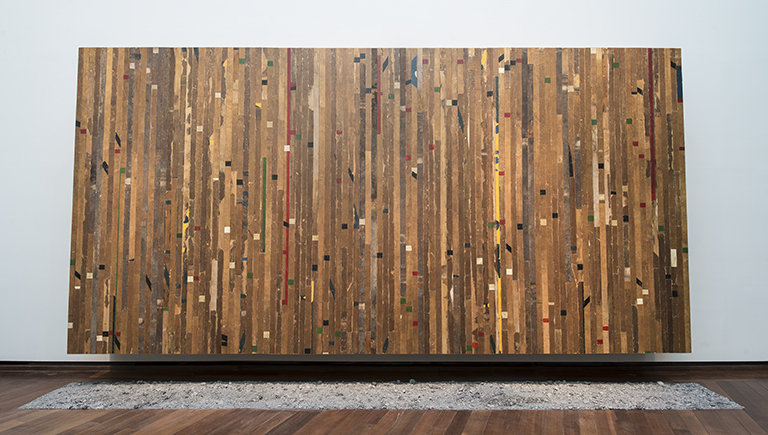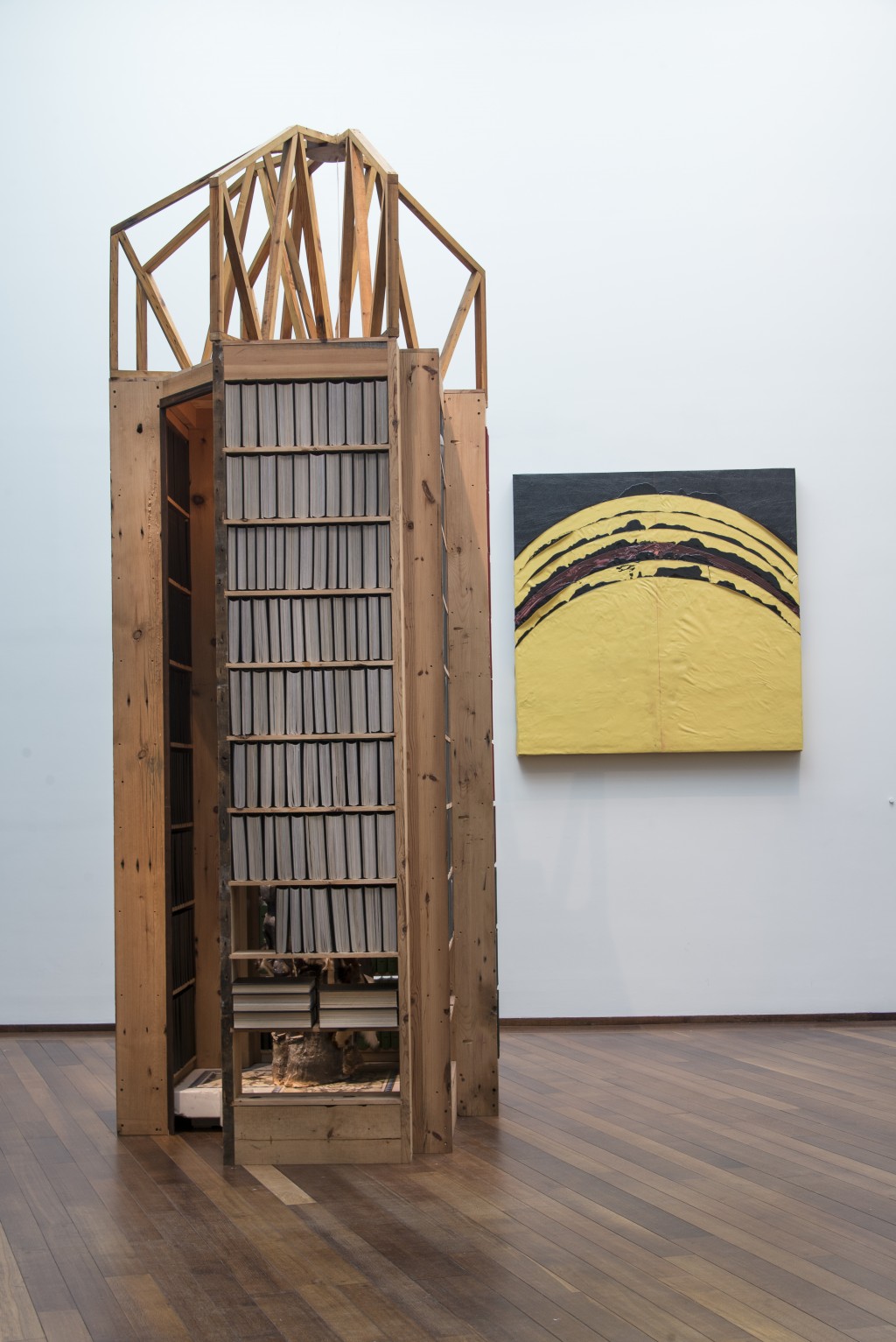IN THE TOWER WITH LANGSTON & THEASTER: A REVIEW OF "THE MINOR ARTS"
Theaster Gates, A Game of My Own, 2017, wood, paint, black stain, Alabama ball clay. (Image courtesy Theaster Gates, White Cube and Regen Projects/National Gallery of Art)
If you were able to show someone what makes you intrinsically you, what would it look like? What kind of material would you use? Where would that material come from? And would it make any sort of sense to a complete stranger?
Probably not. Still, the effort and the end result would be an interesting exegesis of what you find important along with the people and things that collectively comprise a life and give it meaning. Not only would the look of the work be important but the texture as well. Choosing the type of material wouldn’t be easy. Langston Hughes talks about how to explain a life in terms of texture in his poem “Mother to Son”, where he depicts a Mother speaking to her Son about her life’s journey.
“Well, son, I’ll tell you/Life for me ain’t been no crystal stair./It’s had tacks in it/And splinters/And boards torn up/ And places with no carpet on the floor—/ Bare." -LANGSTON HUGHES
"New Egypt Sanctuary of the Holy Word and Image and 12 Suns with Sunset.” (Image courtesy Theaster Gates, White Cube and Regen Projects/National Gallery of Art)
Theaster Gates begins his work on this same basis: by starting at the base and finding the material that describes his experience as if he found the literal set of steps that the narrator of “Mother to Son” speaks of in relation to the harsh experiences she has endured through her life, and his exhibit is telling of the importance of family, community, church, and education, in in his life. Those familiar with Gates might see some definite connections to previous exhibits. Gates’s reverence for the illustrations of W. E. B Du Bois on the data behind black life is definitely on display here once again and has discernible resonance in the piece “12 Suns with Sunset” that follows the color schemes and semi-circular patterns of Du Bois’s original 60 illustrations. Interestingly enough, the preamble to Du Bois’s contribution to “Exhibit of American Negroes” written by Thomas J. Calloway is strikingly similar to the themes and goals of Gates’s piece at National Gallery of Art, where “history”, “education”, “occupation”, “periodicals written or edited by members of the race”, and “church organizations” are at the root of where these materials come from and form the logos that support his own story in relation to the collective experience of a community:
“It was decided in advance to try to show ten things concerning the negroes in America since their emancipation: (1) Something of the negro’s history; (2) education of the race; (3) effects of education upon illiteracy; (4) effects of education upon occupation; (5) effects of education upon property; (6) the negro’s mental development as shown by the books, high class pamphlets, newspapers, and other periodicals written or edited by members of the race; (7) his mechanical genius as shown by patents granted to American negroes; (8) business and industrial development in general; (9) what the negro is doing for himself though his own separate church organizations, particularly in the work of education; (10) a general sociological study of the racial conditions in the United States.”
Gates has found his own source material, culled from experience, in “The Minor Arts”. Each piece exhibits a meticulous, definitively geometric, understanding of “locus”, whether taken from the literal locus of a community: material taken from a school, a church, a bank, the institutions which are important to a community; or collectively: these sets of points that determine the status, condition, of a community. In the piece “New Egypt Sanctuary of the Holy Word and Image” Gates painstakingly arranges and color codes 13,000 volumes of Ebony magazine like points of geometric finding, purposely facing each title inward and asking the viewer to mentally place oneself inside this library while evoking Du Bois’s most critical terminology of “double-consciousness” through the repeated title of “Ebony”. The lighting for the piece is twofold: one consisting of a lone light bulb, wired directly out of the top of the piece to the roof through a wooden weathervane, and the other coming from the natural light of the NGA tower. Gates’s exhibit at the National Gallery, mindfully so, isn’t merely just a collection of his own greatest hits but something telling of an artist that dares to be self-revelatory and wants to give to the viewer. When ascending into the tower of NGA east wing, recently housing Barbara Kruger’s exhibit, the viewer’s attention is immediately drawn to the left. Here is a meticulously reconstructed gym floor from a school not unlike the one Gates would have played on as a child, similar to a school his mother; a schoolteacher by trade, would have been familiar with. Just below the piece is neatly arranged cement sediment, typically found at any demolition site, which leads the viewer to ponder the origins and life span of the place that once housed this material. Education, occupation, and history are all encompassed within the piece and while the viewer inundates, a soundscape of Gates working is heard from the adjacent room as reminder to the reverberations that these themes can have within a community when channeled through craft. The title of the piece, “A Gate of My Own”, brings up not only the passage the viewer must take in visually starting with this piece in relation to the exhibit but the lineage of this material as end product to Gates as an artist: it is a part of him, part of his own name. This arguably would be the backbone of the exhibit if not for the massive tile roof right next it. If the gym boards could be representative of education as matriarch, indicative of the role his mother had as educator to the Gates family and the greater community, the roof could just as much be religion as patriarch: the role that church played in his upbringing and the role that his father, a roofer by trade, had on Gates’s decision to pursue the arts. Coming from an entire side of what was a very prominent church in Gates’s childhood neighborhood, St. Laurence Church, the natural light of the Tower at NGA works beautifully in revealing the different aspects, undulations and blemishes, of each piece of carefully patterned black tile. Together with “A Game of my Own”, the question formulates whether one can take something out of a particular community and still have it retain it’s meaning. Gates admits the title of the exhibit, “The Minor Arts”, refers to the art world’s relegation of all non-western art related to craft to that of a minor influence. The sheer scale and the grand themes inherent within this exhibit effectively turn the title “The Minor Arts” into something of a sarcastic remark.
Theaster Gates: The Minor Arts On view March 5 – September 4, 2017at the National Gallery of Art’s East Building,Tower - Gallery 501. For information, visit nga.gov.


